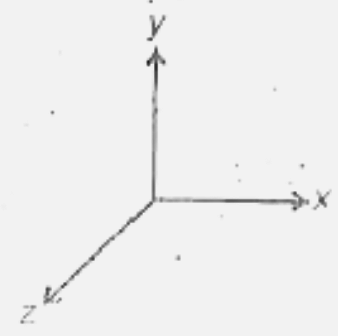let ¯uand¯v be unit vectors. If ¯¯ω is a vector such that ¯¯ω+(¯¯ωׯu)=¯v. Then prove that the maximum volume of the parallelepiped formed by ¯u,¯vand¯¯ω is 1/2.
To solve the problem, we need to prove that the maximum volume of the parallelepiped formed by the vectors ¯u,¯v, and ¯ω is 12.
Step 1: Understanding the Volume of the Parallelepiped
The volume V of the parallelepiped formed by the vectors ¯u,¯v, and ¯ω can be expressed using the scalar triple product:
V=|¯u⋅(¯vׯω)|
This can also be written as:
V=|¯uׯv⋅¯ω|
Step 2: Given Condition
We are given that:
¯ω+(¯ωׯu)=¯v
From this, we can rearrange to express ¯ω:
¯ω=¯v−(¯ωׯu)
Step 3: Substitute ¯ω
Substituting ¯ω into the volume formula:
V=|¯uׯv⋅¯ω|
We can express ¯ω in terms of ¯v and ¯u:
V=|¯uׯv⋅(¯v−(¯ωׯu))|
Step 4: Simplifying the Expression
Using the properties of the scalar triple product:
V=|¯uׯv⋅¯v−¯uׯv⋅(¯ωׯu)|
The first term ¯uׯv⋅¯v=0 because the cross product of any vector with itself is zero.
Thus, we have:
V=|¯uׯv⋅(¯ωׯu)|
Step 5: Using the Vector Identity
Using the vector identity ¯a×(¯bׯc)=(¯a⋅¯c)¯b−(¯a⋅¯b)¯c:
¯u×(¯ωׯu)=(¯u⋅¯u)¯ω−(¯u⋅¯ω)¯u
Since ¯u is a unit vector, ¯u⋅¯u=1:
¯u×(¯ωׯu)=¯ω−(¯u⋅¯ω)¯u
Step 6: Volume Expression
Thus, we can express the volume as:
V=|(¯u⋅¯ω)¯u⋅¯v|
Step 7: Maximizing the Volume
To maximize the volume, we need to maximize |¯u⋅¯v| and |¯u⋅¯ω|. The maximum value of |¯u⋅¯v| occurs when ¯u and ¯v are at 90∘, giving sin(θ)=1.
Thus, the maximum volume is:
Vmax=12
Conclusion
Therefore, we have proved that the maximum volume of the parallelepiped formed by ¯u,¯v, and ¯ω is 12.
---
The volume V of the parallelepiped formed by the vectors ¯u,¯v, and ¯ω can be expressed using the scalar triple product:
V=|¯u⋅(¯vׯω)|
This can also be written as:
V=|¯uׯv⋅¯ω|
We are given that:
¯ω+(¯ωׯu)=¯v
From this, we can rearrange to express ¯ω:
¯ω=¯v−(¯ωׯu)
Substituting ¯ω into the volume formula:
V=|¯uׯv⋅¯ω|
We can express ¯ω in terms of ¯v and ¯u:
V=|¯uׯv⋅(¯v−(¯ωׯu))|
Using the properties of the scalar triple product:
V=|¯uׯv⋅¯v−¯uׯv⋅(¯ωׯu)|
The first term ¯uׯv⋅¯v=0 because the cross product of any vector with itself is zero.
V=|¯uׯv⋅(¯ωׯu)|
Using the vector identity ¯a×(¯bׯc)=(¯a⋅¯c)¯b−(¯a⋅¯b)¯c:
¯u×(¯ωׯu)=(¯u⋅¯u)¯ω−(¯u⋅¯ω)¯u
Since ¯u is a unit vector, ¯u⋅¯u=1:
¯u×(¯ωׯu)=¯ω−(¯u⋅¯ω)¯u
Thus, we can express the volume as:
V=|(¯u⋅¯ω)¯u⋅¯v|
To maximize the volume, we need to maximize |¯u⋅¯v| and |¯u⋅¯ω|. The maximum value of |¯u⋅¯v| occurs when ¯u and ¯v are at 90∘, giving sin(θ)=1.
Vmax=12
Therefore, we have proved that the maximum volume of the parallelepiped formed by ¯u,¯v, and ¯ω is 12.
Similar Questions
Let ¯¯¯¯¯¯PR=3ˆi+ˆj−2ˆkand¯¯¯¯¯¯SQ=ˆi−3ˆj−4ˆk determine diagonals of a parallelogram PQRS and ¯¯¯¯¯¯PT=ˆi+2ˆj+3ˆk be another vector. Then the volume of the parallelepiped determined by the vectors ¯¯¯¯¯¯PT,¯¯¯¯¯¯PQand¯¯¯¯¯PS is
View SolutionPosition vector of a particle moving in x−y plane at time t is r=a(1−cosωt)ˆi+asinωtˆj. The path of the particle is
View SolutionLet zandw be two nonzero complex numbers such that |z|=|w|andarg(z)+arg(w)=π. Then prove that z=−¯¯¯w.
View SolutionIF ¯a,¯b,¯c are vectors from the origin to three points A,B,C show that ¯aׯb+¯bׯc+¯cׯa is perpendicular to the plane ABC.
View SolutionLet ¯a,¯b,¯c be unit vectors such that ¯a+¯b+¯c=¯0. Which one of the following is correct?
View SolutionGiven four non zero vectors ¯a,¯b,¯cand¯d. The vectors ¯a,¯band¯c are coplanar but not collinear pair by pairand vector ¯d is not coplanar with vectors ¯a,¯band¯candˆ¯a¯b=ˆ¯b¯c=π3,(¯d¯b)=β ,If (¯d¯c)=cos−1(mcosβ+ncosα) then m−n is :
View SolutionLet ¯a,¯b,¯c be three non-coplanar vectors and ¯d be a non-zero vector, which is perpendicularto ¯a+¯b+¯c. Now, if ¯d=(sinx)(¯aׯb)+(cosy)(¯bׯc)+2(¯cׯa) then minimum value of x2+y2 is equal to
View SolutionIf z=z0+A(¯z−(¯z0)),whereA is a constant, then prove that locus of z is a straight line.
View SolutionThe complex number associated with the vertices A,B,C of ΔABC are eiθ,ω,¯¯ω, respectively [ where ω,¯¯ω are the com plex cube roots of unity and cosθ>Re(ω)], then the complex number of the point where angle bisector of A meets cumcircle of the triangle, is
View SolutionLight wave travelling along y-direction. If the corresponding ¯¯¯E vector at any time along x-axis, the direction of ¯¯¯B vector at that time is along

View Solution
